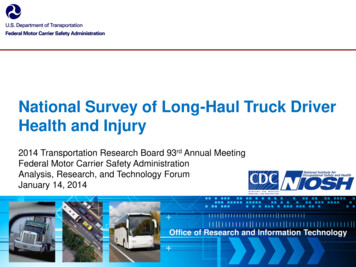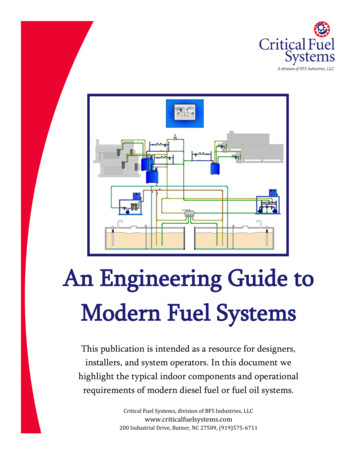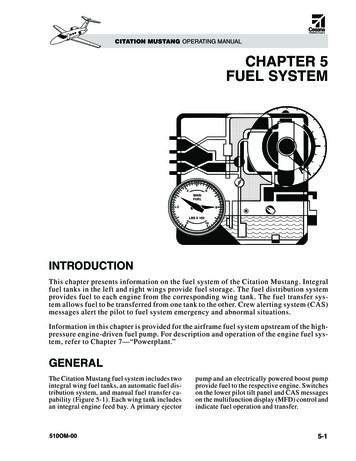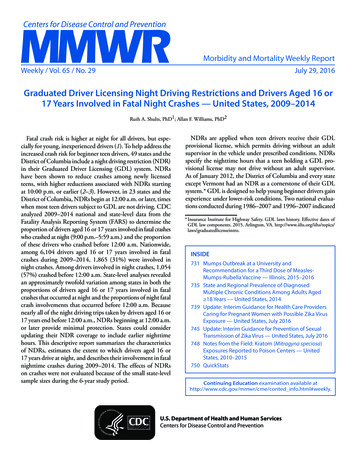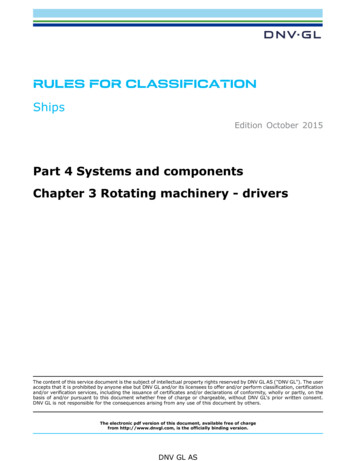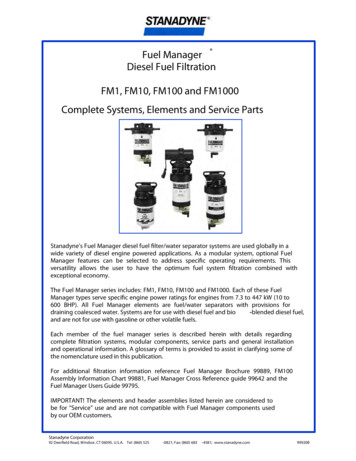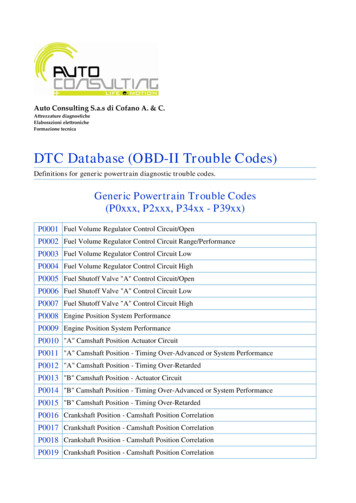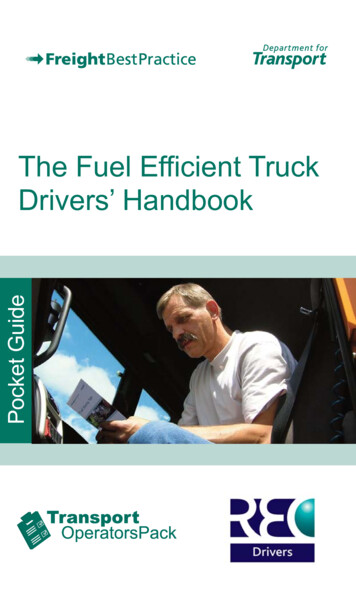
Transcription
Pocket GuideThe Fuel Efficient TruckDrivers’ Handbook
Contents1Introduction - Your Role in Fuel Efficiency12Driving Down Cost - How Does It Affect You?23Factors Affecting Your Fuel Consumption54How To Reduce Your Fuel Consumption75Daily Vehicle Checks216Driver Debrief and Efficient Operations247Why Not Sign Up for a SAFED Course?278Conversion Tables299Further Information3110 Useful Contacts3211 Driver Personal Log35
1Introduction – Your Role inFuel EfficiencyAs a driver, you have a significant impact on fuelconsumption. Alert, positive and professional drivers canreduce fuel use and hence vehicle emissions, operatingcosts and contribute to greater road safety.Remember - You have the single biggest impact on bothfuel consumption and safety.These pages offer advice on:Your impact on operating costsFuel consumption and reduction in emissionsSafe and efficient drivingDriver checklists, conversion tables and furtherinformationHaving the best advice will help you to understand andachieve the benefits of efficient driving. So keep thisinformation handy and improve your efficiency.1
2Driving Down Costs – HowDoes It Affect You?Many professional truck drivers can only guess at how muchis spent on maintenance, tyres, insurance and, crucially,fuel. Whatever vehicle you drive, it is helpful to know howthings add up.In general fuel equates to about 30% of total operating costsso using less fuel makes good business sense and helps theenvironment by reducing emissions.When you understand the operating costs then you canbegin to do something about it. The stronger the business,the better the prospects for the workforce.Take a look at the below example:Table 1 Profits from Fuel SavingsTotal fleet costs 800,000Fuel costs (30% of total) 240,000Profit 40,0005% saving in fuel costs 12,000Profit after fuel saving 52,000Table 1 shows the difference a 5% saving can make to thebottom line profit of a larger fleet company, increasing profitby 30%. This means better opportunities for those at thefrontline, you the driver.Remember - Once you are aware what the truck you drivecosts to run, you’ll be ready to start saving fuel andmoney.2
RememberA rise in profit could improve your job security. Yourcontribution counts!A small improvement in fuel usage can generate alarge increase in profitabilityIf you don’t measure it, how can you manage it?Time spent gathering accurate information on fuelconsumption by recording mileage and fuel use willhelp to pinpoint areas for improvementMaximise your benefits - Understanding how youcan influence current costs through efficient drivingis vital in order to maximise potential benefitsIf you require further information on how tomanage and save fuel, detailed guidance isavailable in the FREE Safe Driving Tips,Engine Idling - Costs You Money andGets You Nowhere! and many other FreightBest Practice publications.These can be ordered via the Hotline0845 877 0 877, or you can download themfrom the websitewww.freightbestpractice.org.uk3
Drivers: You are the key!TURN ITFF!Excessive idling Wastes fuelWastes moneyIncreases emissionswww.freightbestpractice.org.ukPrinted in the UK on paper containing at least 75% recycled fibre.FBP1082 Queens Printer and Controller of HMSO 2007.4
3Factors Affecting Your FuelConsumptionSome factors affecting fuel consumption are outside yourcontrol but it is helpful to understand their effects so you canbegin to measure your MPG effectively and set a benchmarkfor yourself.Experienced and professional drivers can work hard toreduce the impact of these negative factors on fueleconomy. There are simple steps you can take that willincrease your vehicles’ MPG no matter what vehicle youdrive, how congested the roads are and regardless of theweather conditions.The VehicleThe vehicle you are given to drive has a significant influenceon fuel performance in any operation including:Type and specificationAgeConditionEquipment and loadTraffic ConditionsRoad type and traffic conditions have significant effects onfuel use. The more you have to change gear, brake oraccelerate, the more fuel will be used. Variations in trafficcongestion can also create differing performance resultseven though the route is the same.5
WeatherVehicle performance in the winter months can be as muchas 10% poorer than in the summer months. Winterconditions can mean greater use of auxiliary equipment suchas fog lights, screen de-misters, etc, the change from‘summer grade’ diesel fuel to ‘winter grade’ can alsocontribute to a difference in consumption of around 3%.www.freightbestpractice.org.ukPrinted in the UK on paper containing at least 75% recycled fibre.FBP1083 Queens Printer and Controller of HMSO 2007.6
4How To Reduce Your FuelConsumptionFACT! Tests show that by correctly sheeting an emptytipper body at 56mph you could see improvements of over8% (BTAC / IRTE Technical Evaluation Event 2003).FACT! A typical 420hp heavy-duty truck engine consumesfuel at the rate of around two litres an hour when left idlingand stationary.FACT! If tyre pressure falls below recommended figures,rolling resistance increases and fuel is wasted e.g. a 10lbpsi fall in tyre pressure is likely to result in a 1% fall in fueleconomy.FACT! Slow and tortuous routes through hilly terrain willdrag down the fuel performance of even the best vehicle.If you require further information on how tomanage and save fuel, detailed guidance isavailable in the FREE Save It! DVD, FuelSaving Tips, SAFED for HGVs and manyother Freight Best Practice publications.These can be ordered via the Hotline0845 877 0 877, or you can download themfrom the websitewww.freightbestpractice.org.ukThe following section outlines what you can do to improvesafety and fuel economy:7
LOOKING AHEADEvery time you drop down a gear, fuel consumptionincreases. Forward planning helps to reduce excessivegear changes. Use your visibility advantage provided bythe high seating position in a truck. Keeping a vehiclemoving, even at walking pace, requires considerably lessfuel use than moving a vehicle from a standstill.FACT! By planning well ahead and keeping the vehiclemoving, gear changes will be reduced and fuel will besaved.HAZARDSAwareness is essential to road safety. It also enablesearly selection of the gear and speed appropriate for thesituation. The result is a safe and economical drive. Usingthe correct gear, engine speed and position for any givensituation also results in a more environmentally friendlyoperation.FACT! Use of information gained through observationgives more time to plan ahead and systematically avoidhazards.8
SPEEDINGSpeeding is dangerous. It puts your life and the lives ofother road users at risk as well as jeopardising yourdriving licence. In addition, due to the importance of roadspeed in aerodynamic efficiency, speeding will havenegative effects on fuel economy due to increasedaerodynamic drag. Excessive speeding can also put extrastress on the engine and transmission system.FACT! Fuel is directly proportional to the speed your truckis travelling. A 22% reduction in fuel consumption can beachieved simply by reducing your speed from 56 to 50MPHThe Effects of Speed on Fuel Consumption of a HeavyDuty Truck EngineSpeed (MPH) Distance (km)Fuel Used(Litres)0 (idling at480 rpm)01.9 per hour3722.24.115.25022.26.69.55622.28.47.4Source: BTAC/IRTE technical trials of June 20009FuelConsumption(MPG)
Drivers: You are the key!ARE YOU MISSINGUT?It’s not necessary touse every gear Reducing gear changesimproves fuel consumptionwhile avoiding driverfatigue and stress.www.freightbestpractice.org.ukPrinted in the UK on paper containing at least 75% recycled fibre.FBP1084 Queens Printer and Controller of HMSO 2008.10
MOMENTUMThe speed gathered under power can be used to ascendand descend hills on undulating roads without the use ofthe accelerator. On modern, electronically controlledvehicles, when the foot is taken off the accelerator, fuelstops entering the combustion chamber. The vehicle isstill moving, but using no fuel.FACT! Using the momentum of the vehicle will save fuel.CRUISE CONTROLIf you have cruise control, it will help to optimise theelectronic control system’s ability to deliver theappropriate amount of fuel for any given situation, thusimproving fuel efficiency. Remember, cruise controldoesn’t have eyes!FACT! To maximise fuel economy, cruise control shouldbe used whenever safe and appropriate.CLUTCH CONTROLEngaging and disengaging the clutch twice will halve thelife of friction surfaces. This technique is only necessaryfor crash gear boxes. Double-declutching will simplyincrease clutch wear.FACT! Double-declutching is not necessary onsynchromesh gearboxes. It increases clutch wear andwastes fuel.11
SKIP GEARS OR USE BLOCK CHANGESEven when a vehicle is fully laden, it is not normallynecessary to use every gear. The quicker you move upthe gearbox to top gear, the more fuel you will save. As arough rule of thumb, every time you change up a gear youimprove fuel consumption by somewhere between 10%and 30%. Reducing the number of gear changes savestime and energy.FACT! The fewer the gear changes, the less the physicalactivity needed and the more fuel efficient the operation.AVOID UNNECESSARY BRAKINGWhen the footbrake is used the road speed that has beenlost has to be made up by using the accelerator, therebyburning fuel. If it becomes necessary to change down agear or half gear then even more fuel is used. The load isalso more likely to shift under heavy braking.FACT! Harsh braking uses more fuel and requires anincrease in the number of gear changes that you willsubsequently have to make.EXHAUST BRAKEBy using the exhaust brake system instead of thefootbrake, brake lining life is extended. When the exhaustbrake is applied, fuel delivery to the combustion chamberis halted. The vehicle is driven forward by its ownmomentum, so there is no need for fuel to be burnt.FACT! Use of the exhaust brake will contribute tosmoother decreases in speed, increase the lifespan ofbrake linings and save fuel.12
Drivers: You are the key!AHEADForward planning andforward observation ofthe road saves fuel byavoiding heavy brakingand excessive gear changes.www.freightbestpractice.org.ukPrinted in the UK on paper containing at least 75% recycled fibre.FBP1084 Queens Printer and Controller of HMSO 2008.13
MOTORWAYS AND DUAL CARRIAGEWAYSOptimum use of motorways and dual carriageways willresult in a safer, more consistent and more economicaldrive. Wear and tear on the engine and running gear willbe reduced and the vehicle will be able to run at its mosteconomical rate.FACT! Use of constant speeds on motorways and dualcarriageways will enable full use of cruise control, leadingto less gear changes.MANAGE YOUR IDLE TIMEEngine idling wastes fuel and money and increasesemissions. Turn off your engine when you do not need iton or you have been stationary in traffic for any period oftime. Also think before you turn on your engine to warmyour cab.FACT! A typical 420hp heavy-duty truck engine consumesfuel at the rate of around two litres an hour when left idlingand stationary.LOW REVS, LOW NOISE, LOW EMISSIONSLower revs give higher levels of fuel economy. The use ofappropriate horsepower engines (to avoid engine strain)and computer controlled engine management systemsreduces noise levels and assists in maximising fueleconomy.FACT! Quiet operations produce less air pollution.14
Drivers: You are the key!GGREEN15102025530Keeping engine revswithin the green banddramatically improvesfuel consumption.www.freightbestpractice.org.ukPrinted in the UK on paper containing at least 75% recycled fibre.FBP1083 Queens Printer and Controller of HMSO 2008.
www.freightbestpractice.org.ukPrinted in the UK on paper containing at least 75% recycled fibre.FBP1083 Queens Printer and Controller of HMSO 2008.
ADJUSTABLE AERODYNAMICSMany articulated tractor units have adjustable roofmounted air deflectors. The roof mounted air deflectorshould be adjusted to guide airflow over the highest pointat the front of the trailer or load. As a rule of thumb,remember that for every ten centimetres of the front of thetrailer exposed to airflow, the fuel consumption willworsen by 0.1 MPG.FACT! Vehicles that travel at high speeds and have alarge frontal area will use less fuel if fitted with correctlyadjusted aerodynamic body styling equipment.HEIGHT OF THE LOADMinimising the height of the load will save fuel byreducing the drag of the vehicle. This is particularlyrelevant when using a flat-bodied vehicle or trailer.Knowing how to load your vehicle is central to your fuelperformance. Sheeting a load or an empty tipper bodycan save fuel because it reduces aerodynamic drag.FACT! The height of a trailer or load should be kept to aminimum to reduce aerodynamic drag.17
POSITIONING THE LOADThe load should be positioned to reduce aerodynamicdrag but care should be takennot to overload any axles on thevehicle or trailer. Varying theload on each axle can impactfuel consumption.FACT! The positioning of a load, particularly on a flattrailer, can influence fuel consumption.OVERFILLING OF THE FUEL TANKFuel expands when it is hot. It can be heated by both thesun and by fuel returned from the engine or fuel system. Ifyou fill the fuel tank to the brim, then when the fuelexpands, its only way of escape is via the breather vent.Diesel spillages are a hazard to other road users, inparticular motorcyclists.FACT! Overfilling the fuel tank allows fuel to leak throughthe breather.TYRESUnder inflated tyres will reduce MPG and increase wear,thereby reducing tyre life and increasing running costs.FACT! Correctly inflated tyres offer less resistance on theroad, improve fuel economy, give greater stability andreduce the risk of accidents.18
Drivers: You are the key!TURN ITEFFF!An idling truckcan waste up to2 litres of fuelper hour.www.freightbestpractice.org.ukPrinted in the UK on paper containing at least 75% recycled fibre.FBP1082 Queens Printer and Controller of HMSO 2007.19
VEHICLE TECHNOLOGYVehicle technology advances rapidly. Read the vehicle’shandbook to ensure you are fully up-to-date with thesystems installed. Telematics can also be a useful tool tohelp improve operational efficiency.FACT! Technology will only assist in fuel economy andsafe and efficient operation if you are fully familiar withyour vehicle’s systems.And finally Be ready to learn, no matter how experienced you areKnow your average MPG for the vehicle you driveRead your vehicle’s handbookPark up in a way that will avoid early-morningmanoeuvring with a cold engine - this wastes fuel20
5Daily Vehicle ChecksBy law the company and driver are both responsible for theroadworthiness of vehicles. As the driver, you must completea walk-round check (see checklist on page 22) beforeleaving the site at the start of a shift and if appropriate,another check can be made again before booking off fromyour shift.FACT! As a driver you should be aware of how the vehicleyou drive functions and be able to spot any potentialproblems before you start a journey.Any damage to your vehicle at the start of a shift or causedduring the shift must be reported as soon as it is apparent /caused. The following daily check and defect report formmay be used to record any problems you encounter andsubsequently report.If you require further information on how tomanage and save fuel, detailed guidance isavailable in the FREE Fuel Saving Tips,Safe Driving Tips, Drive IT! DVD and manyother Freight Best Practice publications.These can be ordered via the Hotline0845 877 0 877, or you can download themfrom the websitewww.freightbestpractice.org.uk21
Daily /Trailer Registration:Date: / /Odometer Reading:Items to be checked by driver before driving and monitored throughout. A defect should be reported assoon as possible so that the problem can be rectified.Daily Vehicle CheckServiceable/Defect o r Description of Defect(s)Oil/Fuel mber PlateMirrorsReflectorsBrakesTyres (Inflation)Wheels (inc. nuts)Body (damage/dents)Load (secure)Action TakenExhaustBreakdown KitHornWipersWindscreen (damage)TachographDashboard (warning)Speed LimiterDriver Cab/Seat BeltsO Licence Disc/VEDUnder-run barsIn-cab Height IndicatorDefect Corrected:Trailer CouplingSignature:Tail-LiftPrint Name:Demount/Trailer LegsTrailer ConnectionsLoading EquipmentDate: / /Position:Vehicle Check PerformedSignature of the Driver:Print Name:www.freightbestpractice.org.ukApril 2007: Release 122
Think SafetyThink EfficiencyHave you doneyour walk-roundchecks today?www.freightbestpractice.org.ukPrinted in the UK on paper containing at least 75% recycled fibre.FBP1078 Queens Printer and Controller of HMSO 2007.23
6Driver Debrief and EfficientOperationsFACT! By implementing a fuel management programme,a fleet’s fuel consumption can typically be reduced by atleast 5%.Unless you accurately measure the resources you use it isvery difficult to identify areas that can be improved or assessthe impact of any changes that are made.Remember - If you don’t measure performance effectively,how can you change it effectively?Filling in the following forms and assisting in performancemanagement can provide crucial information from whichdecisions and plans can be made. Keeping a log ofperformance will also allow you to pinpoint issues on yourjourney.Remember - By providing your supervisor with accurateinformation, better decisions can be taken on vehiclespecification and routing and scheduling.If you require further information on how tomanage and save fuel, detailed guidance isavailable in the FREE Fleet PerformanceManagement Tool incorporating CO2Calculator and many other Freight Best Practicepublications.These can be ordered via the Hotline0845 877 0 877, or you can download them fromthe website www.freightbestpractice.org.uk24
Driver DebriefsheetPage 1/2Date: / /Vehicle Registration/ Reference: Driver Name/Number:Expenses (please attach receipts):Start Time:Finish Time:Total Hours Worked:OdometerStart:Finish:Approx Empty Mileage:Fuel On Site (litres):Fuel Off Site (litres):Cost per litre ( ):Delays:Details:Compliance and MaintenanceFurther Details: Overloads, Accidents, n:YesNoMaintenance Carried Out:Details: Planned, Unplanned, Tyres, etc:Day Summary:Number of TripsUnits CarriedNo. DeliveriesNo. CollectionsLate DeliveriesDamagesComplaintsNo. Vehicle Defectswww.freightbestpractice.org.ukApril 2007: Release 125
Driver DebriefsheetPage 2/2Delivery/collection details (F Fail, G Good, C Collection, D Damages, S Short Delivery) Please detail ts12345678910111213141516171819202122232425If required, please continue on a new sheetwww.freightbestpractice.org.ukApril 2007: Release 126
7Why Not Sign Up for aSAFED Course?The Safe And Fuel Efficient Driving (SAFED) course is a fullday of off the job training, including practical assessments,theory based papers concerning accident prevention andreduction and fuel efficient driving. It is available for bothHGV and Van drivers so if you are interested, tell yourmanager about the benefits and ask if this is possible.FACT! SAFED training for 6,375 drivers resulted in theindustry saving 10.5 million in fuel. That’s a 1,640saving of fuel per driver.Benefits for YouAs a driver you will develop skills that promote your ownsafety and the safety of your vehicle, load and other roadusers.Personal benefits to you include:Reduced stress levels and enhanced satisfaction ofdrivingIncreased confidence in vehicle control and drivingperformanceImprovements in own vehicle MPGA safe and fuel efficient organisation will reflect wellupon you the driver27
Benefits for Organisations and the EnvironmentSafe and fuel efficient driving contributes to:The development of a health and safety culture withinan organisationEffective risk managementReducing CO2 and other harmful vehicle emissionsReducing vehicle and personal injury accidents /incidentsA safe and fuel efficient driver will reflect well upon theorganisationRemember - You have the single biggest impact on safetyand fuel economy.More information and a list of instructors in your area canbe found at www.safed.org.ukIf you require further information on how tomanage and save fuel, detailed guidance isavailable in the FREE SAFED for HGVs,Companies and Drivers Benefit fromSAFED for HGVs and many other FreightBest Practice publications.These can be ordered via the Hotline0845 877 0 877, or you can download themfrom the websitewww.freightbestpractice.org.uk28
8Conversion TablesFACT! For every 1 litre of diesel burnt 2.63 kg of CO2 isreleased into the atmosphere. How can that be? Achemical reaction takes place during combustion whichcombines the carbon produced by the flame with oxygenin the air to give Carbon Dioxide.To ConvertToMultiply tresgallons (UK)0.21997gallons (UK)litres4.54609gallons (US)gallons (UK)0.83268gallons (UK)gallons (US)1.20094horsepower(James Watt) –abbreviated to hpkilowatts (kW)0.746kilowattshorsepower (hp)1.341horsepower (hp)metric horsepower (PS)1.0139metric horsepower (PS)horsepower (hp)0.9863tons (imperial)tonnes (metric)1.016tonnes (metric)tons (imperial)0.984Fuel performance is usually measured in MPG or litres per100 kilometres, although kilometres per litre and miles perlitre are also used.29
Some Benchmark ValuesMiles / GallonLitres / 100km10 MPG28.25 litres / 100km9 MPG31.4 litres / 100km8 MPG35.3 litres / 100kmMiles per hourKm per hour30 MPH48 kph40 MPH64 kph50 MPH80 kph56 MPH90 kph60 MPH97 kphKm per hourMiles per hour50 kph31 MPH70 kph44 MPH90 kph56 MPH100 kph62 MPH110 kph68 MPH30
9Further InformationIf you are interested in obtaining more detailed informationon Fuel Management methods and systems, you may findthe following guides useful:Drive It! DVD - A 25 minute driver focussed DVDcovering aspects of operational efficiencySave It! DVD - An introduction to Freight BestPractice and the ways in which fuel can be savedInformation Technology for Efficient Road freightOperations - Provides an overview of the availableand relevant IT systems for road freight operationsSAFED for HGVs: A Guide to Safe and FuelEfficient Driving for HGVs - Outlines the elements ofthe Safe and Fuel Efficient Driving schemeFuel Management Guide - The definitive guide toimproving the fuel performance of your fleetTelematics for Efficient Road Freight Operations Provides information on the components of telematicssystems and their implementationHighways Agency Truckstop Guide - A detailedguide to 102 sites across the country31
10 Useful ContactsDepartment for TransportTel: 020 7944 8300www.dft.gov.ukInformation relating to the provision of a reliable, safeand secure transport system that responds to the needsof individuals and business whilst safeguarding ourenvironmentDriver and Vehicle Licensing AgencyTel: 0870 240 0009 (Driver Enquiries)Tel: 0879 240 0010 (Vehicle Enquiries)www.dvla.gov.ukThe DVLA facilitate road safety and general lawenforcement by maintaining registers of drivers,vehicles, and collecting vehicle excise dutyDriving Standards AgencyTel: 0115 901 2500www.dsa.gov.ukThe DSA’s aim is to promote road safety throughimproving driving standards via tests; maintaining aregister of instructors; and supervising training forlearner motorcyclistsHealth and Safety ExecutiveTel: 08701 545500www.hse.gov.ukResponsible for the regulation of almost all the risks toheath and safety arising from work activity in England32
Highways Agency Traffic InformationTel: 08700 660 115www.highways.gov.uk/trafficA Highways Agency website providing real-timeinformation on both traffic conditions and trafficforecasts across the countryMET Office (Weather Advice)Tel: 0870 900 0100www.met-office.gov.ukThe MET office provides environmental andweather-related services to the general public,government and almost every other industry sectorSkills for LogisticsTel: 0870 6060440www.skillsforlogistics.orgSkills for Logistics is the Sector Skills Council whichworks alongside companies involved in moving,handling or storing goodsVehicle and Operator Services Agency (VOSA)Tel: 0870 6060440www.vosa.gov.ukVOSA provides a range of licensing, testing andenforcement services with the aim of improving theroadworthiness standards of vehicles ensuring thecompliance of operators and drivers with road trafficlegislation33
Work ContactsMain Reception:Tel:Mobile:Traffic Office:Tel:Mobile:Warehouse:Tel:Mobile:Service e:Tel:Mobile:34
11 Driver Personal LogFill in your daily hours and expenses and keep for your ownpersonal records (please photocopy for repeated use)Date aySaturdaySundayTotal35Job DetailsExpenses
Freight Best Practice publications, including those listed below, can beobtained FREE of charge by calling the Hotline on 0845 877 0 877 or bydownloading them from the website www.freightbestpractice.org.ukSaving FUELFuel Driving TipsThis handy pocket guide is ideal fordrivers and managers looking forsimple ways to reduce fuelconsumption.Case STUDIESPerformance MANAGEMENTFleet Performance ManagementTool Incorporating CO2 CalculatorThis tool has been designed to helpfleet operators improve theiroperational efficiency using keyperformance indicators (KPIs) tomeasure and manage performance.KPIs include costs, operational,service, compliance, maintenanceand environmental.Engine Idling – Costs You Moneyand Gets You Nowhere!This case study provides evidencefrom 4 operators that by implementinganti-idling strategies an operator cansave money by reducing fuelconsumption and at the same timedecrease CO2 emissions.Transport Operators’ Pack -TOPTOP provides practical ‘every day’support material to help operatorsimplement best practice in theworkplace and acts in direct support oftasks essential to running a successfulfuel management programme.Equipment & SYSTEMSTelematics for Efficient Road FreightOperationsThis guide provides information onthe basic ingredients of telematicssystems, highlights how to use thistechnology, the information obtainedfrom it and how to select the rightsystem for your needs.Developing SKILLSSafe Driving TipsWritten especially for commercialvehicle drivers, this pocket-sizedguide provides essential safety hintsand tips on all aspects of drivingsafely.April 2009.Printed in the UK on paper containing at least 75% recycled fibre.FBP1091 Queens Printer and Controller of HMSO 2009.Saving FUEL
800,000 : Fuel costs (30% of total) 240,000 : Profit ; 40,000 : 5% saving in fuel costs : 12,000 : Profit after fuel saving : 52,000 : Table 1 shows the difference a 5% saving can make to the


